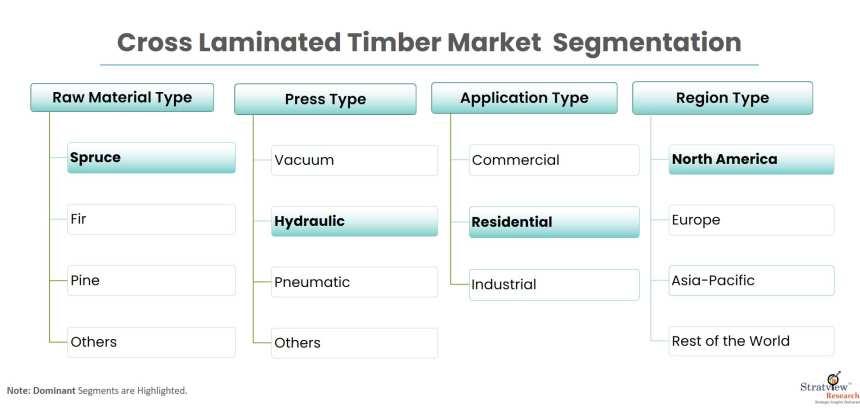Cross-Laminated Timber (CLT) is rapidly transforming the construction landscape. This innovative engineered wood product boasts exceptional strength, dimensional stability, and environmental benefits, making it a sustainable and versatile alternative to traditional building materials. This article explores the key trends shaping the CLT market, its diverse applications, and the promising future that lies ahead.
Current Market Landscape
The global CLT market is experiencing robust growth, fueled by a confluence of factors:
- Market Size:According to Stratview Research, the global cross laminated timber market size was valued at USD 1.56 billion in 2023 and it is expected to reach USD 2.99 billion in 2028, growing at a CAGR of 13.89% during the forecast period of 2023-2028.
- Sustainability: CLT's eco-friendly credentials are a major driver. Wood is a renewable resource, and CLT utilizes sustainably managed forests, promoting carbon sequestration.
- Superior Building Properties: Exceptional strength-to-weight ratio, dimensional stability, and seismic resistance make CLT suitable for various construction applications.
Key Trends Shaping the Market
Several prominent trends are influencing the CLT market:
- Growing Focus on Sustainability: Environmental concerns are driving the demand for sustainable building materials. CLT's ability to reduce a building's carbon footprint aligns perfectly with this trend.
- Rise of Prefabrication: Prefabrication of CLT panels streamlines the construction process, offering faster completion times, improved quality control, and reduced on-site waste.
- Technological Advancements: Automation and digitalization in CLT production are enhancing efficiency, lowering costs, and facilitating the creation of complex architectural designs.
- Stringent Regulations: Governments worldwide are implementing stricter environmental regulations, promoting the adoption of sustainable building materials like CLT.
Diverse Applications of CLT
CLT's versatility extends beyond traditional applications, making it suitable for various construction projects:
- Residential Sector: CLT is increasingly used for walls, floors, and roofs in single-family homes, multi-unit dwellings, and student housing.
- Non-residential Buildings: CLT finds applications in commercial buildings, educational institutions, public facilities, and industrial structures.
- High-Rise Construction: Advancements in CLT technology are enabling its use in high-rise buildings, pushing the boundaries of sustainable construction.
- Interior Design: CLT's aesthetic appeal makes it suitable for exposed beams, ceilings, and other interior design elements.
- Infrastructure Projects: CLT bridges and other infrastructure elements are being explored due to the material's inherent strength and durability.
Future Outlook: A Sustainable Trajectory
The CLT market is poised for significant growth in the coming years, driven by several factors:
- Growing Environmental Concerns: As the focus on sustainability intensifies, CLT's eco-friendly properties will continue to propel its adoption.
- Government Support: Policymakers are expected to introduce incentives and favorable regulations to encourage the use of sustainable building materials like CLT.
- Public Awareness: Growing public awareness of the environmental benefits and superior building properties of CLT will drive market demand.
Here are some anticipated future developments:
- Development of Hybrid Construction Techniques: CLT will likely be integrated with other sustainable materials like steel and concrete to optimize structural performance.
- Expansion into New Applications: Innovative uses of CLT in bridges, transportation infrastructure, and even furniture are expected to emerge.
- Focus on Life-Cycle Cost Analysis: As the industry recognizes CLT's long-term benefits like energy efficiency and reduced maintenance costs, its initial cost premium will become less of a barrier.
Challenges and Opportunities
Despite the promising outlook, the CLT market faces certain challenges:
- Limited Production Capacity: The current production capacity needs to expand to meet the growing demand for CLT.
- Standardization: Standardization in building codes and regulations across different regions is crucial for wider CLT adoption.
- Skilled Labor: Training and upskilling the workforce in CLT construction techniques is essential to ensure proper implementation.
However, these challenges present exciting opportunities:
- Investment in Production Facilities: Increased investment in CLT manufacturing facilities can address the supply gap and cater to the rising demand.
- Collaboration between Stakeholders: Collaboration between governments, industry players, and research institutions can facilitate knowledge sharing, innovation, and the development of standardized building codes.
- Focus on Education and Training: Investing in educational programs and training initiatives can address the need for a skilled CLT workforce.
